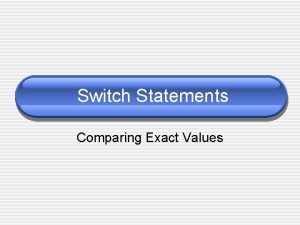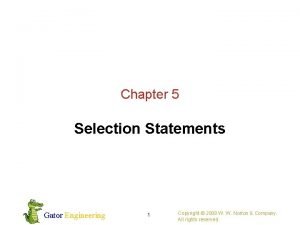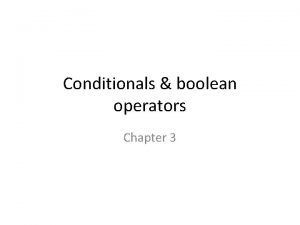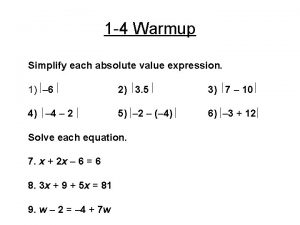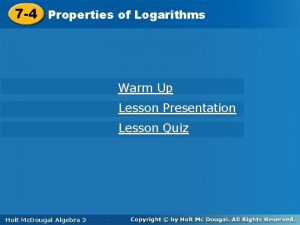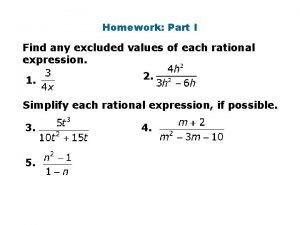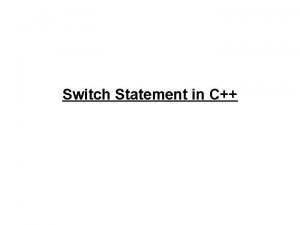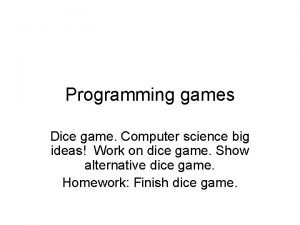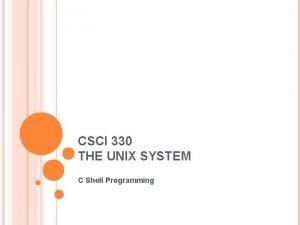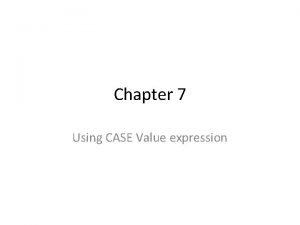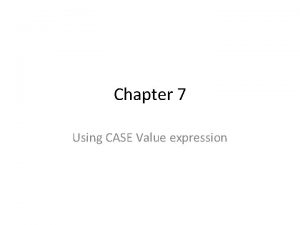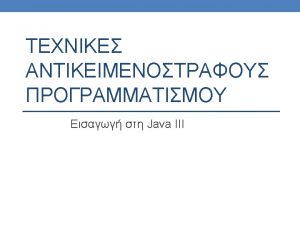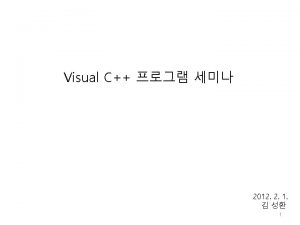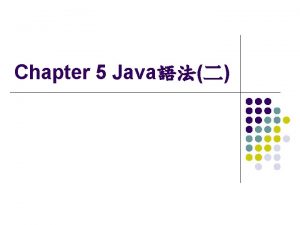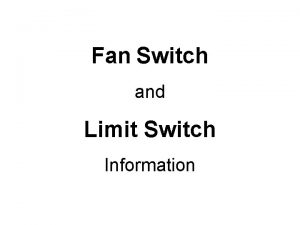switch Statements switch expression case value 1 statements















- Slides: 15

switch Statements switch (expression) { case value 1: statement(s); break; case value 2: statement(s); break; …. case value. N: statement(s); break; default: statements(s); } 34

switch Statement Flow Chart 35

switch Statement Rules The switch-expression must yield a value of char, byte, short, or int type and must always be enclosed in parentheses. The value 1, . . . , and value. N must have the same data type as the value of the switch-expression. The resulting statements in the case statement are executed when the value in the case statement matches the value of the switchexpression. Note that value 1, . . . , and value. N are constant expressions, meaning that they cannot contain variables in the expression, such as 1 + x. switch (switch-expression) { case value 1: statement(s)1; break; case value 2: statement(s)2; break; … case value. N: statement(s)N; break; default: statement(s)-for-default; } 36

switch Statement Rules The keyword break is optional, but it should be used at the end of each case in order to terminate the remainder of the switch statement. If the break statement is not present, the next case statement will be executed. The default case, which is optional, can be used to perform actions when none of the specified cases matches the switchexpression. switch (switch-expression) { case value 1: statement(s)1; break; case value 2: statement(s)2; break; … case value. N: statement(s)N; break; default: statement(s)-for-default; } The case statements are executed in sequential order, but the order of the cases (including the default case) does not matter. However, it is good programming style to follow the logical sequence of the cases and place the default case at the end. 37

animation Trace switch statement Suppose ch is 'a': switch case } (ch) 'a': 'b': 'c': { System. out. println(ch); 38

animation Trace switch statement ch is 'a': switch case } (ch) 'a': 'b': 'c': { System. out. println(ch); 39

animation Trace switch statement Execute this line switch case } (ch) 'a': 'b': 'c': { System. out. println(ch); 40

animation Trace switch statement Execute this line switch case } (ch) 'a': 'b': 'c': { System. out. println(ch); 41

animation Trace switch statement Execute this line switch case } (ch) 'a': 'b': 'c': { System. out. println(ch); 42

animation Trace switch statement Execute next statement switch case } (ch) 'a': 'b': 'c': { System. out. println(ch); Next statement; 43

animation Trace switch statement Suppose ch is 'a': switch (ch) { case 'a': System. out. println(ch); break; case 'b': System. out. println(ch); break; case 'c': System. out. println(ch); } 44

animation Trace switch statement ch is 'a': switch (ch) { case 'a': System. out. println(ch); break; case 'b': System. out. println(ch); break; case 'c': System. out. println(ch); } 45

animation Trace switch statement Execute this line switch (ch) { case 'a': System. out. println(ch); break; case 'b': System. out. println(ch); break; case 'c': System. out. println(ch); } 46

animation Trace switch statement Execute this line switch (ch) { case 'a': System. out. println(ch); break; case 'b': System. out. println(ch); break; case 'c': System. out. println(ch); } 47

Trace switch statement Execute next statement switch (ch) { case 'a': System. out. println(ch); break; case 'b': System. out. println(ch); break; case 'c': System. out. println(ch); } Next statement; 48
 Best case worst case average case
Best case worst case average case Contoh value creation adalah
Contoh value creation adalah A quadratic expression is an expression of
A quadratic expression is an expression of The resources need to be reserved during the setup phase in
The resources need to be reserved during the setup phase in Go proximity limit switch
Go proximity limit switch Switch statement syntax
Switch statement syntax Are switch statements faster than if/else
Are switch statements faster than if/else Purposeful expression of feelings in social work
Purposeful expression of feelings in social work It reverses the value of a boolean expression
It reverses the value of a boolean expression Absolute value warm up
Absolute value warm up 7-4 properties of logarithms
7-4 properties of logarithms Excluded value
Excluded value Switch statement c++ char
Switch statement c++ char Select case visual basic .net
Select case visual basic .net Game theory switch case
Game theory switch case Command line arguments in unix
Command line arguments in unix





